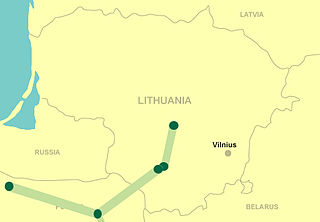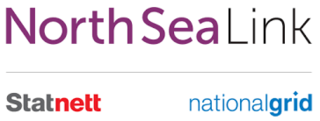
A high-voltage direct current (HVDC) electric power transmission system uses direct current (DC) for electric power transmission, in contrast with the more common alternating current (AC) transmission systems.

The Baltic Cable is a monopolar HVDC power line running beneath the Baltic Sea that interconnects the electric power grids of Germany and Sweden. Its maximum transmission power is 600 megawatts (MW).

The HVDC Cross-Channel is the 73-kilometre-long (45 mi) high-voltage direct current (HVDC) interconnector that has operated since 1986 under the English Channel between the continental European grid at Bonningues-lès-Calais and the British electricity grid at Sellindge. The cable is also known as IFA, and should not be confused with the new IFA-2, another interconnect with France that is three times as long but only half as powerful.

The National Grid is the high-voltage electric power transmission network serving Great Britain, connecting power stations and major substations, and ensuring that electricity generated anywhere on the grid can be used to satisfy demand elsewhere. The network serves the majority of Great Britain and some of the surrounding islands. It does not cover Northern Ireland, which is part of the Irish single electricity market.

Path 27, also called the Intermountain or the Southern Transmission System (STS), is a high-voltage direct current (HVDC) electrical transmission line running from the coal-fired Intermountain Power Plant near Delta, Utah, to the Adelanto Converter Station at Adelanto, California, in the Southwestern United States. It was installed by Asea, a company based in Sweden, and commercialized in July 1986. The system is designed to carry power generated at the power plant in Utah to areas throughout Southern California. It is owned and operated by the Intermountain Power Agency, a cooperative consisting of six Los Angeles-area cities, the largest member being the Los Angeles Department of Water and Power (LADWP), and 29 smaller Utah municipalities.
NorNed is a 580-kilometre (360 mi) long high-voltage direct current submarine power cable between Feda, Norway and the seaport of Eemshaven in the Netherlands, which interconnects both countries' electrical grids. It was once the longest submarine power cable in the world. Budgeted at €550 million, and completed at a cost of €600m, the NorNed cable is a bipolar HVDC link with a voltage of ±450 kV and a capacity of 700 MW. NorNed is a joint project of the Norwegian transmission system operator Statnett and its Dutch counterpart TenneT. The cable system itself and the two converter stations were produced by ABB.
Directlink (Terranora)Interconnector is a mixed buried and above ground 59 kilometre (37 mi) High Voltage Direct Current (HVDC) electricity transmission cable route from near Lavertys Gap (28°34′15″S153°27′8″E), 5 kilometres (3.1 mi) Southwest of Mullumbimby, New South Wales and Bungalora (28°15′20″S153°28′20″E) & connected via a 3.5km (2.2mi) AC Overhead Transmission Line to the NorthEast to the Terranora Electrical Substation (28°14′28.3″S153°30′12.7″E) @ Terranora, New South Wales New South Wales in Eastern Australia. The DC cables alternate between above ground in a galvanised steel trough and below ground with depths up to 1m.

A submarine power cable is a transmission cable for carrying electric power below the surface of the water. These are called "submarine" because they usually carry electric power beneath salt water but it is also possible to use submarine power cables beneath fresh water. Examples of the latter exist that connect the mainland with large islands in the St. Lawrence River.
The East–West Interconnector is a 500 MW high-voltage direct current submarine and subsoil power cable which connects the Irish and British electricity markets. The project was developed by the Irish national grid operator EirGrid.
NordBalt is a submarine power cable between Klaipėda in Lithuania and Nybro in Sweden. The purpose of the cable is to facilitate the trading of power between the Baltic and Nordic electricity markets, and to increase the supply and energy security in both markets.

LitPol Link is an electricity link between Poland and Lithuania which connects the Baltic transmission system to the synchronous grid of Continental Europe. It has a capacity of 500 MW and since 2021 it can operate in a synchronous regime.
NordLink is a subsea 1,400 megawatt (MW) HVDC power cable between Norway and Germany, opened in May 2021. The over 500 kilometres (310 mi) long cable operates at a voltage of 500 kV DC.

The synchronous grid of Continental Europe is the largest synchronous electrical grid in the world. It is interconnected as a single phase-locked 50 Hz mains frequency electricity grid that supplies over 400 million customers in 24 countries, including most of the European Union. In 2009, 667 GW of production capacity was connected to the grid, providing approximately 80 GW of operating reserve margin. The transmission system operators operating this grid formed the Union for the Coordination of Transmission of Electricity (UCTE), now part of the European Network of Transmission System Operators for Electricity (ENTSO-E).
TenneT is a transmission system operator in the Netherlands and in a large part of Germany.

A wide area synchronous grid is a three-phase electric power grid that has regional scale or greater that operates at a synchronized utility frequency and is electrically tied together during normal system conditions. Also known as synchronous zones, the most powerful is the Northern Chinese State Grid with 1,700 gigawatts (GW) of generation capacity, while the widest region served is that of the IPS/UPS system serving most countries of the former Soviet Union. Synchronous grids with ample capacity facilitate electricity trading across wide areas. In the ENTSO-E in 2008, over 350,000 megawatt hours were sold per day on the European Energy Exchange (EEX).
BritNed is a 1,000 MW high-voltage direct-current (HVDC) submarine power cable between the Isle of Grain in Kent, the United Kingdom; and Maasvlakte in Rotterdam, the Netherlands.

The North Sea Link is a 1,400 MW high-voltage direct current submarine power cable between Norway and the United Kingdom.

Denmark's western electrical grid is part of the Synchronous grid of Continental Europe whereas the eastern part is connected to the Synchronous grid of Northern Europe via Sweden.
Shetland HVDC Connection is a high-voltage direct current submarine power cable under construction to connect Shetland to the British mainland.










